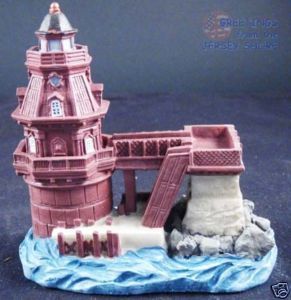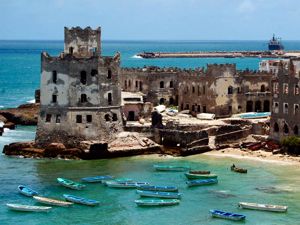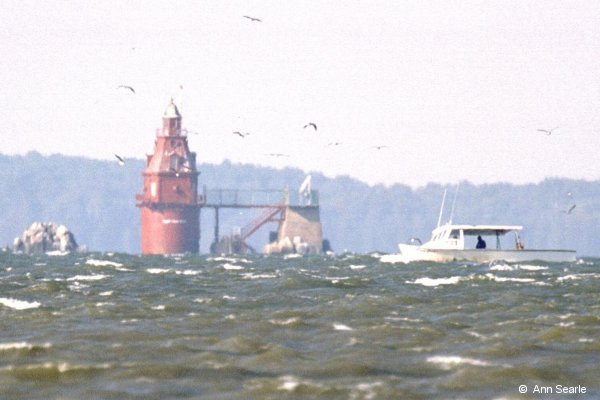Construction of the Ship John Shoal Lighthouse in Delaware Bay took 27 years, from a decision by the US Congress in 1850 that a light was needed, through various incarnations of caisson-foundations, screw-pile roots, 2000 tons of rip-rap, and a temporary anchored lightship, to placement of the completed iron tower in 1877.
The lighthouse went unmanned in 1973, and as recently as last month (June 2011) it was declared no longer necessary by the Coast Guard and made available for public sale.

Ship John Shoal sitting on a heap of concrete and rip-rap. Image by Nick Zelinski.
The Shoal upon which the lighthouse sits came to be named ‘Ship John’ in 1797, when the ship John ran aground there while on the last leg of a transatlantic voyage from Germany. It was Christmas Eve, and doubtless the 60 German crew were looking forward to festivities in Philadelphia. Instead they were off-loaded and transported up river to smaller settlements up Cohansey River, where they spent the holiday with strangers.
There was time enough to unload the cargo of linen, glass, rope, copper nails, gin, and German toys, before the ship John was frozen into the thick winter ice and its fate was sealed.
Ship John Shoal flocked by gulls, with a boat for scale. Image by Ann Searle.

Red-brown iron-paneling, emergent from the water. Image by Ann Searle.
In 1850 a screw-pile light-house was approved for the shoal, a design where long metal piles are literally screwed into soft undersea mud. However when ice floes carried away a lighthouse using the new technology, a new approach was considered: a caisson, basically just a hollow metal tube sunk into the ocean then filled with concrete, to form a solid base.
By 1874 there was a temporary light atop the caisson with two keepers in attendance, but they abandoned their post that winter due to huge chunks of ice battering the caisson, prompting the fear that it would be rolled away. 2000 tons of rip-rap, which is rubble used to ‘armor’ coasts and sea-borne structures, was dropped around the caisson to protect it from ice. Soon after, in 1877, the 125-foot tall permanent iron superstructure was fastened atop the caisson, and the Ship John Shoal Light began its life proper.

A simple model of the Ship John Shoal Light. Image from ebay.

A more detailed version, minus the side-long storage tank. Image from Harborlights.

Details on the model, showing clearly the mansard roof and stylings around the windows. The interior was lined with insulating, and more comfortable, wood. Image from Harborlights. Visit similar locations via Deal Checker Flights to Florida
Various stories of life for the keepers on the Ship John Light have been passed down.
– One tells of a curse in the 1880’s, a sickness that left several keepers sick or paralyzed after extended stays. This continued for several years, until it was discovered that the structure’s red leaded paint was washing into the rainwater tanks. The old paint was removed and replaced with a coating of hot tar. Health at once improved, and the curse was lifted.
– Another story dates to 1903, when random inspections of the light were a regular feature. One keeper at that time was married, and often brought his wife out to the shoal despite a regulation that women were not allowed on the light (perhaps because they’d be far too sexy and distracting). When the random inspector came he powdered his wife with coal-dust and had her hide in the coal bin basement. The inspector however found her knitting in the man’s room, but he claimed it was his own- something to pass the time. He continued his inspection even to the basement, but the wife hid so well and stayed so still he never found her.
Though apparently he came back a few months later, and caught them then.
– A Keeper named Wells described the conditions on board around 1900 as lonely and monotonous, though with 200 to 300 visitors per year, and 8 days shore-leave per month, it was not as bad as duty at some other lights.

Ship John Shoal and storage tank.
Text Sources- Wikipedia, Lighthouse Friends
.
Dead Sentinels: 10 abandoned lighthouses
1. Rubjerg-Knude, Denmark |
2. Talacre, Wales |
 |
 |
| Construction of the Rubjerg-Knude lighthouse in Jutland, Denmark straddled the last two centuries, beginning in 1899 and finishing in 1900. | The Talacre lighthouse, officially titled ‘Point of Ayr’, has stood on Talacre Beach in various incarnations since 1776, watching over ships make the trek across Liverpool Bay from the Welsh town of Lllandudno. |
3. Tillamook, USA |
4. Mogadishu, Somalia |
 |
 |
| The Tillamook Rock Light was built in 1881 on a rock off Oregon coast. It was born in blood; with its grand opening overshadowed by a nearby shipwreck just days before its guardian gas-light was lit. | The crumbling Italian lighthouse perched on the edge of Mogadishu’s Old Harbor was built over a century ago, and abandoned some 20 years ago as trade dried up to the failed state of Somalia. |
5. Grand Cay, Bahamas |
6. Klein Curacao, Caribbean |
 |
 |
| The lighthouse on Great Isaac Cay, a small island in the Bahamas around 20 miles north-east of the Bimini Islands, was built in 1859 to guide trade-ships carrying exports of sun-dried sea salt from Inagua | The Klein Curacao (‘Little Curacao’) lighthouse was first built in 1850, on a tiny spit of land 11km off the southeastern tip of Curacao in the Caribbean Sea. |
7. Capo d’Otranto, Italy |
8. Aniva Rock, Russia |
 |
 |
| The Capo d’Otranto lighthouse was built in 1867, situated at Italy’s most eastern point, marking the point where the Ionian and Adriatic Seas meet. It was abandoned in the 1970’s | The Aniva lighthouse was built by the Japanese in 1939, on a chunk of rock off the southern coast of Sakhalin, a thin 950 km long island situated just east of Russia. |
9. Ship John Shoal, USA |
10. Fish Fluke Point, Canada |
 |
 |
| Construction of the Ship John Shoal Lighthouse in Delaware Bay took 27 years, from a decision by the US Congress in 1850 that a light was needed through various incarnations. | The Grand Harbor Lighthouse on Fish Fluke Point, Ross Island, was built in 1879, a square wooden tower 32-feet tall with the Keeper’s dwelling attached. |
See many more abandoned places in the ruins gallery.
Explore more Japanese ruins (haikyo) in the galleries:
[album id=4 template=compact]You can also read SF & Fantasy stories inspired by ruins.
If you enjoyed this post, why not SUBSCRIBE.


Comments 1
Fantastic selection. Congrats